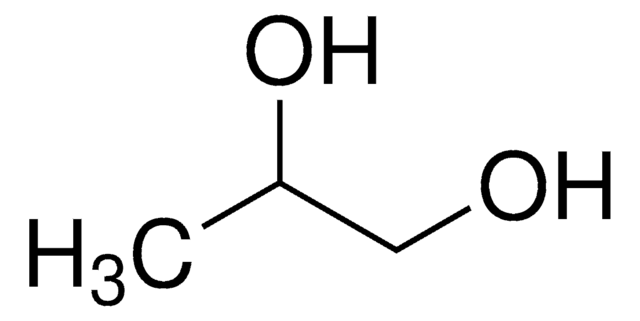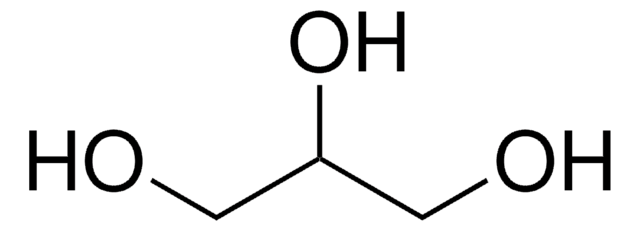12279
1,2-Propanediol
analytical standard
Synonym(s):
1,2-PDO, Propylene glycol
About This Item
Recommended Products
grade
analytical standard
Quality Level
vapor density
2.62 (vs air)
vapor pressure
0.08 mmHg ( 20 °C)
assay
≥99.7% (GC)
autoignition temp.
779 °F
shelf life
limited shelf life, expiry date on the label
expl. lim.
12.5 %
technique(s)
HPLC: suitable
gas chromatography (GC): suitable
refractive index
n20/D 1.432 (lit.)
n20/D 1.433
bp
187 °C (lit.)
mp
−60 °C (lit.)
density
1.036 g/mL at 25 °C (lit.)
application(s)
cleaning products
cosmetics
environmental
flavors and fragrances
food and beverages
forensics and toxicology
personal care
pharmaceutical (small molecule)
format
neat
SMILES string
CC(O)CO
InChI
1S/C3H8O2/c1-3(5)2-4/h3-5H,2H2,1H3
InChI key
DNIAPMSPPWPWGF-UHFFFAOYSA-N
Looking for similar products? Visit Product Comparison Guide
General description
Find all available reference materials for compounds listed in 10/2011 here
Application
wgk_germany
WGK 3
flash_point_f
closed cup
flash_point_c
closed cup
ppe
Eyeshields, Gloves
Choose from one of the most recent versions:
Certificates of Analysis (COA)
Sorry, we don't have COAs for this product available online at this time.
If you need assistance, please contact Customer Support.
Already Own This Product?
Find documentation for the products that you have recently purchased in the Document Library.
Customers Also Viewed
Protocols
99%; Glycerol, ≥99.5%; Tetraethylene glycol, 99%
Chromatograms
suitable for GCsuitable for GCOur team of scientists has experience in all areas of research including Life Science, Material Science, Chemical Synthesis, Chromatography, Analytical and many others.
Contact Technical Service


